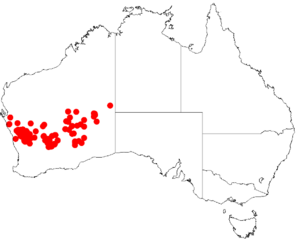Acacia sibina
Quick facts for kids Acacia sibina |
|
|---|---|
| Scientific classification | |
| Genus: |
Acacia
|
| Species: |
sibina
|
 |
|
| Occurrence data from AVH | |
Acacia sibina is a type of tree or shrub. It belongs to a large group of plants called Acacia, which are often known as wattles in Australia. This particular acacia grows naturally only in certain parts of western Australia.
About the Plant
This tree or shrub usually stands straight up. It can grow from about 1 to 4 metres (3 to 13 ft) tall. Its small branches are smooth, meaning they don't have hairs.
The leaves of Acacia sibina are quite special. They are called phyllodes. Phyllodes are like flattened leaf stems that do the job of leaves. These phyllodes stand upright and are straight or slightly curved. They are stiff and have a blue-green color. Each phyllode can be from 6 to 22 cm (2.4 to 8.7 in) long and 1 to 2 m (3 ft 3 in to 6 ft 7 in) wide. They have a strong smell and faint lines along them.
This plant blooms from August to October. It produces bright yellow flowers. The flowers grow in simple groups, usually in pairs, where the phyllodes join the stem. Each flower group looks like a cylinder, about 7 to 22 mm (0.28 to 0.87 in) long and 7 mm (0.28 in) wide. These flower spikes are packed with many golden-colored flowers.
After the flowers, seed pods start to form. These pods are firm and shaped like a line. They are bumpy where each seed sits inside. The pods are smooth and can grow up to 12 cm (4.7 in) long and 4 to 6 mm (0.16 to 0.24 in) wide. Inside, the seeds are shiny and dark brown. They are arranged lengthwise in the pod. Each seed is oval-shaped, about 3.5 to 4 mm (0.14 to 0.16 in) long, and has a yellow aril. An aril is a fleshy covering around the seed.
Plant History
This plant was first officially described in 1977. It was named by a botanist named Bruce Maslin.
Where It Grows
A. sibina grows naturally across a large area in Western Australia. You can find it in the Mid West, Goldfields, and Wheatbelt regions. It often grows on flat areas, sandy plains, or rocky hills. It prefers gravelly, yellow, or red sandy soils, or loamy soils that sit over a hard layer called laterite.

